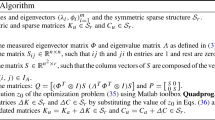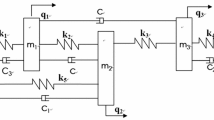Abstract
The tridiagonal coefficient matrix for the “fixed-fixed” spring-mass system was obtained by changing spring length. And then a new algorithm of the inverse problem was designed to construct the masses and the spring constants from the natural frequencies of the “fixed-fixed” and “fixed-free” spring-mass systems. An example was given to illustrate the results.
Similar content being viewed by others
References
Jiang Er-xiong. An inverse problem of natural frequencies and its solution[J]. Journal of Vibration and Shock, 1983, 2(3): 1–6 (in Chinese).
Jiang Er-xiong. Symmetric Matrix Computation[M]. Shanghai: Shanghai Scientific and Technical Press, 1984 (in Chinese).
Gladwell G M L. Inverse Problems in Vibration[M]. 2nd ed. Dordrect: Kluwer Academic Publishers, 2004.
Gladwell G M L, Willms N B. The reconstruction of a tridiagonal system from its frequency response at an interior point[J]. Inverse Problems, 1988, 4: 1013–1024.
Nylen P, Uhlig F. Inverse eigenvalue problems associated with spring-mass systems[J]. Linear Algebra and Its Application, 1997, 254: 409–425.
Nylen P, Uhlig F. Inverse eigenvalue problem: existence of special spring — mass systems [J]. Inverse Problems, 1997, 13: 1071–1081.
Ram Y M, Caldwell J. Physical parameters reconstruction of a free-free mass-spring system from its spectra [J]. SIAM Journal on Applied Mathematics, 1992, 52(1): 140–152.
Ram Y M. Inverse eigenvalue problems for a modified vibration system [J]. SIAM Journal on Applied Mathematics, 1993, 53(6): 1762–1775.
Hochstadt H. On some inverse problems in matrix theory[J]. Archives of Mathematics, 1967, 18: 201–207.
de Boor C, Golub G H. The numerically stable reconstruction of a Jacobi matrix from spectral data[J]. Linear Algebra and Its Application, 1978, 21: 245–260.
Hatter D J. Matrix Computer Methods of Vibration Analysis[M]. London: Butterworth, 1973.
Horn R A, Johonson C R. Matrix Analysis[M]. Cambridge, Eng.: Cambridge University Press, 1985.
Author information
Authors and Affiliations
Corresponding author
Additional information
Project supported by the National Natural Science Foundation of China(Grant No.10271074)
About this article
Cite this article
Wu, Xq., Jiang, Ex. Solution of an inverse problem for “fixed-fixed” and “fixed-free” spring-mass systems. J. of Shanghai Univ. 11, 27–32 (2007). https://doi.org/10.1007/s11741-007-0104-3
Received:
Revised:
Issue Date:
DOI: https://doi.org/10.1007/s11741-007-0104-3
Keywords
- spring-mass system
- inverse problem in vibration
- inverse eigenvalue problem
- Jacobi matrix
- natural frequency




